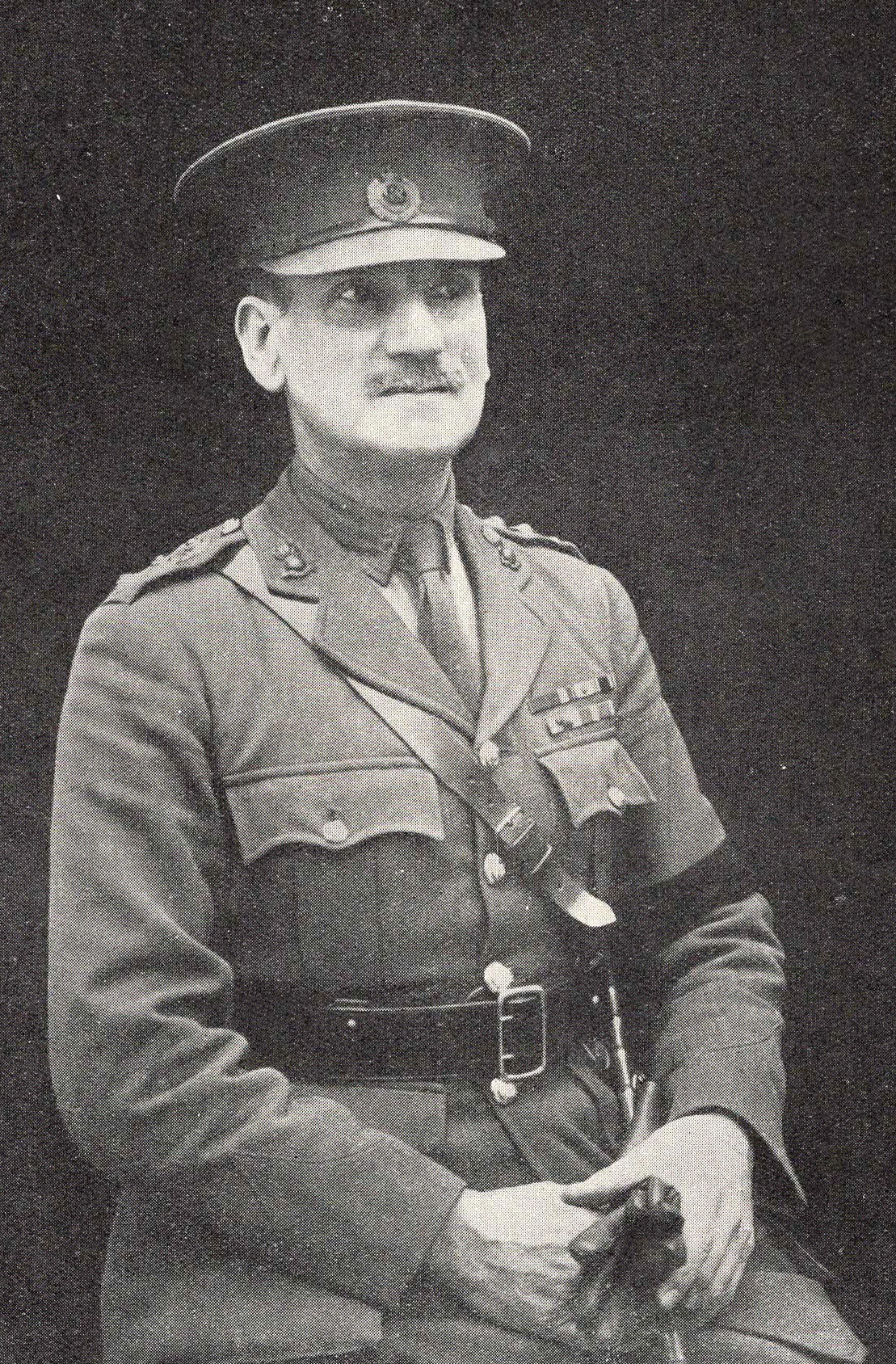
Figure 1. Captain George Thomas Northover, R.E., circa 1936.
(Image from The Sapper, May 1936)[1]
Captain
(Quartermaster)
GEORGE THOMAS NORTHOVER
Royal Engineers
By
Lieutenant Colonel Edward De Santis, MSCE, P.E.,
MinstRE
(April 2023)

Figure 1. Captain George Thomas Northover, R.E., circa
1936.
(Image from The Sapper, May 1936)[1]
1. INTRODUCTION
The principal references used in the preparation of this narrative were from a number of sources. They include census records, official registries in the United Kingdom, a number of family trees, Army Lists, and The London Gazette. All sources are contained in the REFERENCE section at the end of the narrative and are cited throughout in the ENDNOTES. Where the sources of specific items of information are not cited, the reader should assume that the information was taken from Captain Northover’s retirement notice published in the May 1936 issue of The Sapper magazine. Every effort has been made to accurately portray the life and military service of Captain Northover.
Attempts to reconstruct his family life were made difficult by problems encountered with the family trees found on Ancestry.com. There were two men by the name of George Thomas Foster who were contemporaries during their lifetimes. Researchers attempting to construct the family tree of each man appear to have become confused and put information for one man into the family tree of the other man. Military information pertaining to the service of the other man was often credited to G.T. Northover, the principal character of this work, who served in the Royal Engineers. Spouses and children also became mixed up as did the dates and places where certain events occurred. I have tried to correct these errors where I found them, but I cannot be certain that I found them all.
Family Information
George Thomas Northover was the son of Thomas Northover (1858-1926), a native of Hounslow, Middlesex,[2] and Fanny Northover, née Thurley (1859-?), a native of Hatfield, Hertfordshire.[3]
Early Life
George was born in Acton, Middlesex on 27 May 1881. At the time of his birth his parents were living at 1 Rothschild Terrace in Acton and his father was a Police Constable for the area. In 1883 Thomas and Fanny had another child, Fanny E. Northover (1883-1952), who also was born in Acton.
By 1891 the Northover family was living in Twickenham as indicated by the census for that year.
1891 Census of England
Census Place: Burton Lodge, Twickenham, Middlesex. |
|||||
Name and Surname of each Person |
Relation |
Marital Status |
Age |
Profession or Occupation |
Birthplace |
Thomas Northover |
Head |
Married |
33 |
Police Sergeant |
Hounslow, |
Fanny Northover |
Wife |
Married |
30 |
|
Hatfield, |
George T. Northover |
Son |
|
9 |
Scholar |
Acton, |
Fanney E. Northover |
Daughter |
|
8 |
Scholar |
Acton, |
3. ENLISTMENT AND TRAINING
Enlistment
In April of 1896, just short of his 15th birthday, George Thomas Northover decided to enlist as a Boy Soldier in the Royal Engineers. Boy enlistment was a traditional method of augmenting recruitment for a corps or regiment. Regiments consisting entirely of boys had been formed at an earlier date, but the last had disappeared in 1802. Between 1859 and 1899 regulations specified that the number of boys was not to exceed 2 per cent of the establishment. Boys were taken on from the age of fifteen and served an apprenticeship until they reached the normal age of enlistment. During this time they were taught one of two or three trades. Nearly three-quarters of the boys recruited underwent training as musicians (i.e. drummers and buglers), the remainder as tailors and shoemakers. On reaching the minimum age for enlistment, boys formally joined the regiment to which they were attached.
Upon his enlistment, young George was issued Regimental Number 33 and was posted to the Royal Engineers headquarters at Chatham, Kent. The duties that he performed at Chatham are not known, but they assuredly were one of the trades listed above. On 16 March 1897 he was posted to the 16th (Service) Company at Bedford, Bedfordshire. The 1897 Army List shows this unit as a Service Company, but it would soon be converted to a Survey Company.
Training
In June 1899, upon attaining 18 years of age, George joined the ranks and was posted back to Chatham as a Sapper. He joined No. 8 Squad for that year and began his recruit training. With the exception of Drivers, every recruit enlisted for the Royal Engineers had to have a trade. Pioneers and Sappers were sent to Chatham where they were trained for a year in infantry drill and pioneer duties. During the summer every training company in turn went into a tent-camp at Wouldham near Chatham, where the recruits were taught camp duties, pontooning and other field engineering tasks. The engineer recruits also received musketry training. When the course of training was completed the recruits had to pass an examination and were then transferred to engineer formations, where they received higher pay and could earn extra allowances by working at their special trades. It appears that Northover was qualified as a Surveyor when he completed training at Chatham.
4. POSTINGS AND CAMPAIGN SERVICE
South Africa (1900-1905)
In December 1899 Northover was promoted to the rank of Lance Corporal and in the following month he was posted to the 5th Field Company at Aldershot, Hampshire, which at the time was mobilizing for service in the South African war with the 8th Infantry Division. The division’s Commander Royal Engineers (C.R.E.) was Colonel T.R. Main and Northover’s company commander was Major B.E. Morony, R.E. The 8th Infantry Division occupied the eastern part of the Orange Free State and in May of 1900 it was located at Senekal. Northover and his company took part in operations against the Boers in the Cape Colony and Transvaal and at the Battle of Wittebergen and he was wounded in the arm at Ficksburg.[4] Apparently the wound was not serious enough for him to be returned home. He remained with the 5th Field Company until 1905 when the unit returned to the U.K.
Curragh Camp, Ireland (1905).
When Northover return to the U.K. he was posted to Curragh Camp, an area in Ireland used for training by the British Army. At the time of Northover’s arrival there the Commander Royal Engineers of the camp was Brevet Colonel G.K. Scott-Moncrieff, CIE.[5] Also located there was the 57th Field Company under the command of Major F.E.G. Skey, R.E. Northover may have gone to Curragh Camp for training as his stay there was a very short one. He was posted to Ordnance Survey duties at Southampton in June 1905.
|
Figure 2. George K. Scott-Moncrieff as
a Young Lieutenant.
|
Southampton (1905-1914)
Northover’s posting to the Ordnance Survey in Southampton was the beginning of the rest of his career in the Army – a career that would be dedicated to surveying. Southampton was the location of the Ordnance Survey headquarters and in 1905 the 19th Survey Company was located there. He remained at Southampton for nine years, with a short tour of duty in Canada in 1909, probably involved with surveying duties there.
1911 Census of England and Wales
Census Place: 137 Earls Road, Southampton, Hampshire. |
|||||
Name and Surname of each Person |
Relation |
Marital Status |
Age |
Profession or Occupation |
Birthplace |
George T. Northover |
Head |
Married |
29 |
Lance Corporal Royal Engineers |
Acton, |
Gertrude Louise Northover |
Wife |
Married |
30 |
|
Bitterne, |
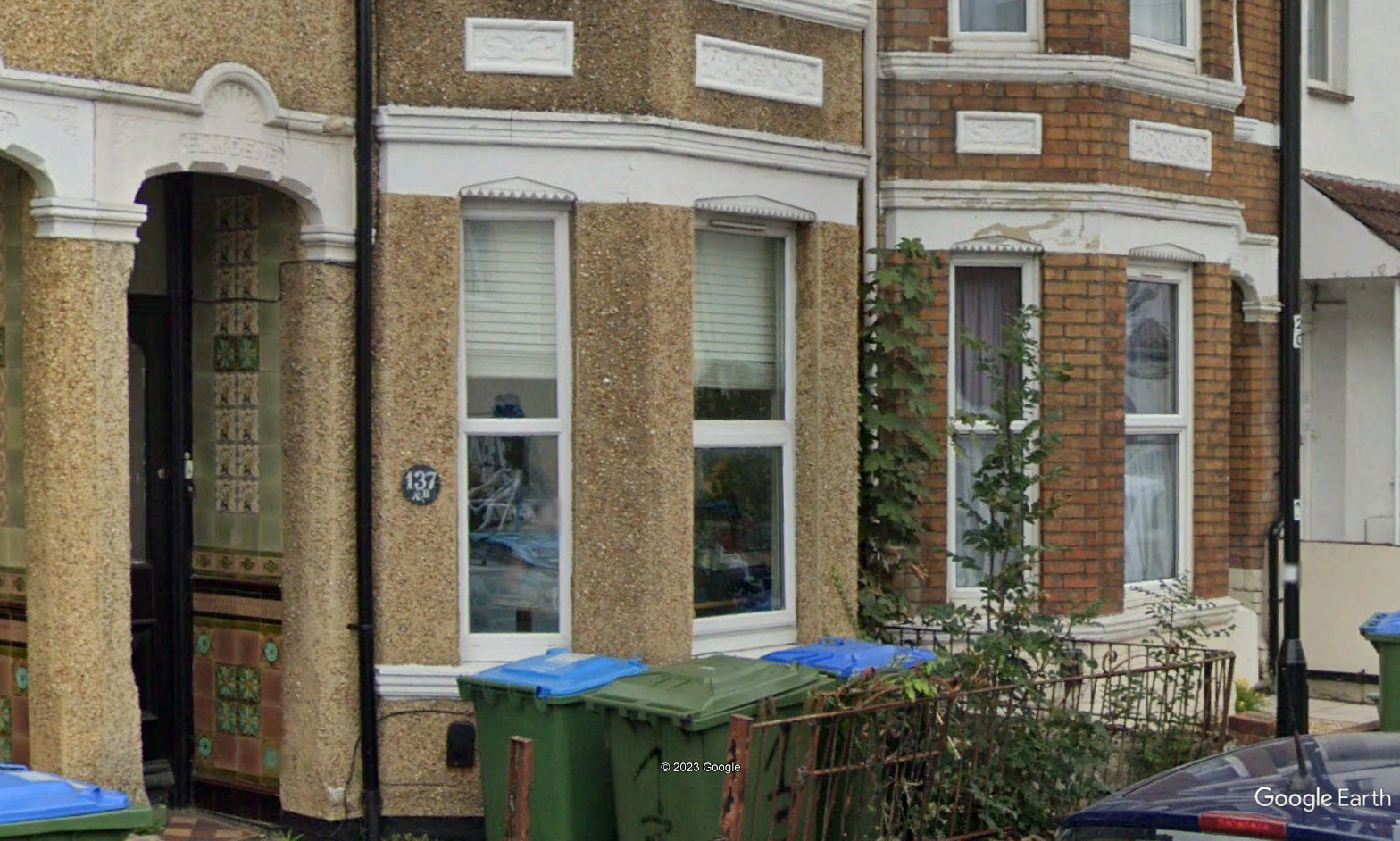
Figure 3. The Northover Home at 137 Earls Road in
Southampton.
(Image courtesy of Google Earth)
Northover’s chief sport was shooting and in 1914, before the start of the Great War, he demonstrated his skill with a rifle by placing 2nd in the British Empire Grand Aggregate competition of the National Rifle Association.[6] This was a competition in which the best marksman from military units in the British Empire participated. The competitors were the best of the best, and for Northover to score so highly was a testament to his proficiency with the rifle.
France (1914-1915)
Soon after the Great War of 1914-1918 started, Northover, then a Corporal, was posted to the 57th Field Company in the 3rd Infantry Division. Based in the Southern Command in the U.K. when the war broke out in August 1914, the units making up the 3rd Division were dispatched to France to join the British Expeditionary Force (B.E.F.). As part of British II Corps, they were all ashore by 16th August 1914 and went straight up to the front at Mons. Northover, however, did not arrive in France until 7 October 1914.[7]
Taking up positions along the Mons-Conde canal, the division gave a good account of itself (the first three Victoria Crosses of the war were won by men from the division on this day, but at a high cost - more than 3,000 casualties. The retreat from Mons followed, along with service on the Aisne before moving up to Flanders in early October 1914 to take part in the fighting south of Armentières. It was here, on October 14th at Vielle Chapelle, that the division's first commander, Major General H.I.W.Hamilton was killed - in fact, he was the first British divisional commander to die in the Great War. Killed by shell fire, Hamilton's body was taken back to England for burial. By the end of November 1914 the division as a whole had suffered 8,355 casualties since mid-October.
On 8 October 1914, the day after Northover’s arrival in France, the 57th Field Company was at Pont Le Grand and on 9 October it was at Tollent. It was there that the company suffered its first fatality since Northover’s arrival in the unit. The casualty was 197714 Sapper John Donohoe.[8]
Between 10 October and 2 November 1914 the 57th Field Company was heavily engaged in the Battle of La Bassee. It moved almost continuously during the battle in support of the division’s actions as described above. The following is a summary of those moves taken from the unit’s War Diary:
8 October: Detrained at Abbeville
10 October: At Tangry
11 October: At L’Ecleme
12 October: At Les Lobes
13-15 October: At Vielle Chappelle making ladder bridges for the infantry
16 October: At Rue Du Bouquetaine
19-26 October: At Herlies L’Iventure and La Cliqueterie
1 November: At Sailly
2 November: At Estraire building a pontoon bridge over the River Lys.
During the winter of 1914/1915 the company worked on improving trenches, repairing roads, improving billets, manufacturing trench stores, and making makeshift bombs, grenades, periscopes and trench mortars.
In early 1915 the 3rd Division moved up to the Ypres Salient, and took over the trenches opposite the Messines Ridge, and at St Eloi and The Bluff. On 5 March 1915, while the company was at Kemmel marking out new trenches and superintending the digging of new trenches, Corporal Northover was wounded in the chest, probably by shrapnel from an artillery shell. It appears that he was evacuated to the U.K. and on 31 May he was mentioned in the despatches of Field Marshal Sir John French for his gallant and distinguished service in the field.[9]
The Dardanelles (1915-1916)
Northover returned to duty in September 1915 presumably after recovering from his wound. His next posting was rather an unusual one. He was posted to the Royal Navy on the staff of the Chief Hydrographer in the Dardanelles during the Gallipoli campaign. What his qualifications were for this posting is not known. Hydrographers measure water depth, and search for shoals, rocks, and wrecks that could be hazards to navigation. They also collect information on water levels and tides. Just why Northover would have been selected for this posting remains a mystery. The timing of this appointment coincides with military operations at Gallipoli, so presumably Northover was assisting the Royal Navy with the landings on that peninsula. It is quite possible that Northover’s skills as a Surveyor were used to help map out water depths and the shape of the sea floor and coastline in preparation for the landings at Gallipoli.
Southampton (1916-1919)
Northover returned to Ordnance Survey Headquarters at Southampton after completing his work with the Royal Navy in the Dardanelles. During the Great War the Ordnance Survey was involved with producing numerous maps of the battlefield areas in France and Flanders. Northover could have been employed on this type of work during the years prior to the end of the war.
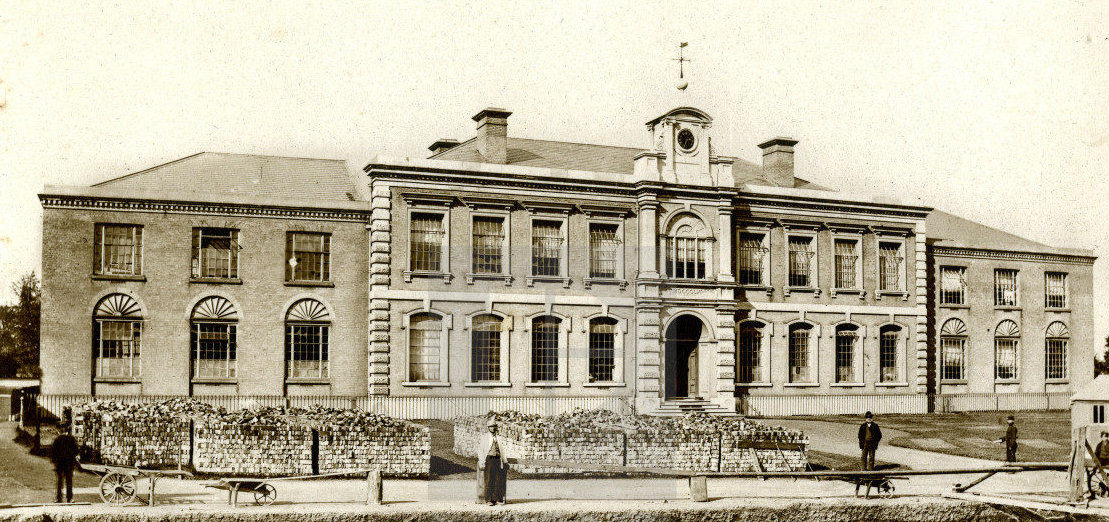
Figure 4. Ordnance Survey
Headquarters Building, Southampton, Hampshire.
(Image
courtesy of Wikipedia)
Dublin (1919-1921)
In May 1919 Northover was posted to the Ordnance Survey in Ireland. He was stationed at Mountjoy House in Phoenix Park where he was the Superintendent for Printing and Photography and the Paymaster for the office. By this time in his career he must certainly have been a Warrant Officer, probably a Quartermaster Sergeant (Warrant Officer Class II).
On 20 November 1921, while serving in Ireland, Northover was commissioned a Lieutenant (Quartermaster) in the Royal Engineers. This appointment paved the way for him to serve well beyond the 21 years normally associated with service in the ranks. It also was the reason for his posting back to the Ordnance Survey headquarters in Southampton where he would remain for about 15 years until he left the service.
|
Figure 5. Mountjoy House,
|
Southampton (1921-1936)
After returning to Southampton from Ireland, Northover began the longest posting of his career. In addition to being the headquarters of the Ordnance Survey, Southampton was also the home of the Survey Battalion, which consisted of the 13th and 19th Survey Companies. As a Quartermaster, Northover might have served on the staff of the Ordnance Survey or the staff of the Survey Battalion, or he could have served as the Quartermaster of either of the Survey Companies. Unfortunately the research of his military service did not reveal his precise duties during this 15-year period.
The June 1926 edition of the Monthly Army List indicates that he was serving on the Board of Agriculture and Fisheries with the Ordnance Survey at Southampton. Just how agriculture and fisheries became associated with the Ordnance Survey and the military is rather curious and much too convoluted to discuss here; however, such was the case with Lieutenant Northover’s posting at Southampton.
The March 1929 issue of The Sapper magazine describes a meeting of the Royal Engineers Old Comrades Association (R.E.O.C.A.)[10] which Northover attended on 19 January 1929. The function was the annual reunion and dinner of the R.E.O.C.A. branch in Southampton and about 90 members met at a place called Prices Café in Southampton for the occasion. The meeting was presided over by Brigadier E.M. Jack, CB, CMG, DSO who was the Director General of Ordnance Survey. Lieutenant Northover attended this meeting and dinner.[11] On 8 February 1929 Northover attended the Royal Engineers Ball at Kingsway Hall in Southampton. Brigadier Jack also attended this function.
On 26 November 1929 Northover was promoted to the rank of Captain (Quartermaster).[12] With this promotion he most likely was serving on Brigadier Jack’s staff of the Ordnance Survey, or quite possibly on the staff of the Survey Battalion. The Monthly Army List of October 1935 shows Captain Northover still serving with the Board of Agriculture and Fisheries with the Ordnance Survey at Southampton. He retired from active service on 27 May 1936.[13]
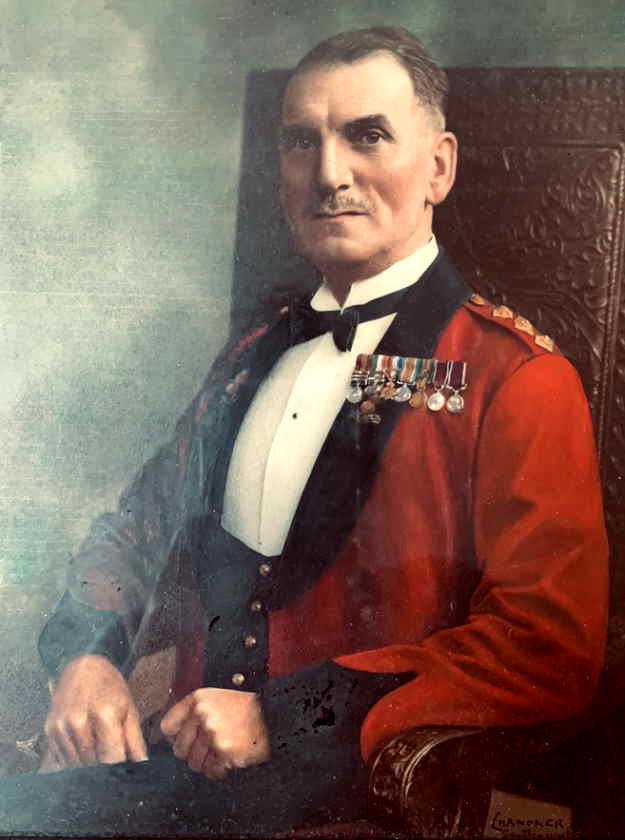
Figure 6. Captain (Quartermaster)
George Thomas Northover, R.E.
(Image
courtesy of David Brooks)
Figure 6 above is a photograph of Captain Northover in his mess dress, perhaps taken at the time of his retirement from the Army. It clearly shows all of his medals, which will be discussed in detail in Section 7 below.
The following sections are presented in tabular form to summarize Northover’s promotions, appointments, and the medals that he was awarded during his time in the Army. They are provided to give the reader easy access to these aspects of his military career. The tables are followed by sections dealing with his marriage, family, personal information and post-service life.
5. PROMOTIONS AND APPOINTMENTS
Promotions: Northover received the following promotions during his time in service:
Date of Promotion or Appointment |
|
April 1896 |
Enlisted as a Boy Soldier in the Royal Engineers. |
June 1899 |
Posted to the ranks as a Sapper upon attaining 18 years of age. |
December 1899 |
Appointed Lance Corporal. |
1905 |
Promoted 2nd Corporal. |
1911 |
Promoted Corporal. |
1917 |
Promoted Sergeant. |
1920 |
Promoted Quartermaster Sergeant. |
20 November 1920 |
Appointed Temporary Lieutenant (Quartermaster) |
29 April 1921 |
Promoted Lieutenant (Quartermaster) |
26 November 1929 |
Promoted Captain (Quartermaster) |
NOTE: The years
and ranks shown in italics above have been approximated by the author
as the year that Northover may have been promoted. Since his
service papers were not available for this research project it was
not possible to find definitive dates for these promotions.
Appointments: Northover received the following appointments during his time in service:
Date of Appointment |
|
January 1900 |
Junior Non-Commissioned Officer (NCO) in a Field Company |
June 1905 |
Surveyor |
September 1915 |
Staff NCO for the Chief Hydrographer, Royal Navy |
May 1919 |
Superintendent for Printing and Photography; Paymaster |
April 1921 |
Staff Officer, Ordnance Survey, Board of Agriculture and Fisheries. |
6. MEDALS, AWARDS AND DECORATIONS
Captain Northover received the following service medals and awards during his time in service:
For service in the South African War, 1899-1902
Queen’s South Africa Medal with clasps [CAPE COLONY][TRANSVAAL] [WITTEBERGEN]
King’s South Africa Medal with clasps [SOUTH AFRICA 1901][SOUTH AFRICA 1902]
For service in the Great War, 1914-1918
1914 Star and bar with rosette.
British War Medal.
Victory Medal with oak leaf for Mention in Despatches.
For long and meritorious service and good conduct
Army Long Service and Good Conduct Medal (GVR).
Army Meritorious Service Medal (GVR).
King George V Jubilee Medal.
In Figure 6 he is shown with all of his medals (from right to left on his jacket as he is wearing them) except for the King George V Jubilee Medal. He was awarded this medal after the photograph was taken, which helps to date the photograph to late 1935 or early 1936. He was awarded the Army Long Service and Good Conduct Medal in 1917. No record could be found to determine the date of his award of the Meritorious Service Medal, but it was determined that the medal was not an immediate award.[14] It was awarded prior to November 1921.
7. RELEASE FROM SERVICE
Captain Northover was retired from service on 26 May 1936, having attained the mandatory age for continued service. His total service was reckoned as shown in the tables below. The period of service at many locations has been estimated since exact dates are not known in many cases.
Location |
|
Chatham |
April 1896 – 15 March 1897 |
Bedford |
16 March 1897 – June 1899 |
Aldershot |
June 1899 – May 1900 |
South Africa |
May 1900 – February 1905 |
Curragh Camp, Ireland |
February 1905 – June 1905 |
Southampton |
June 1905 - 1909 |
Canada |
1909 - 1910 |
Southampton |
1910 – 6 October 1914 |
France |
7 October 1914 – 5 March 1915 |
Home (medical leave) |
6 March 1915 – September 1915 |
Dardanelles |
September 1915 – January 1916 |
Southampton |
January 1916 – May 1919 |
Dublin |
May 1919 – 10 December 1921 |
Southampton |
11 December 1921 – 26 May 1936 |
Location |
|
Home Service |
35 years, 9 months and 140 days |
Service Abroad |
4 years, 9 months and 271 days |
Total Service |
40 years and 26 days |
NOTE: His Home Service includes approximately 3 years and 2 months as a Boy Soldier.
8. POST SERVICE LIFE
After retiring from the Army, Northover resided at 128 Rownhams Lane to the north of Southampton at least until 1939.[15] No information could be found regarding his occupation after leaving the Army. He was 58 years old in 1939 and the register lists his occupation as “Army Officer, retired.” While in the Army his chief sport had been shooting, so perhaps he continued doing this after he retired. His name does appear in the 1943 edition of The Royal Engineers List, so he may well have been active in a branch of the Royal Engineers Association up to the time of his death.
George Thomas Northover died on 18 April 1956 at the age of 74 at 11 Medina Road in Shirley, Southampton. Probate of his will took place in Winchester on 4 July 1956 with his effects going to the National Provincial Bank Limited in the amount of £1,280-7s-7d (about $49,700 US in 2023 currency). As his effects were left to a bank, the bank may have been responsible for paying off any outstanding debts that Northover may have had before paying the residual amount to his wife and/or daughter. This seems logical as he predeceased his wife by about 10 years.
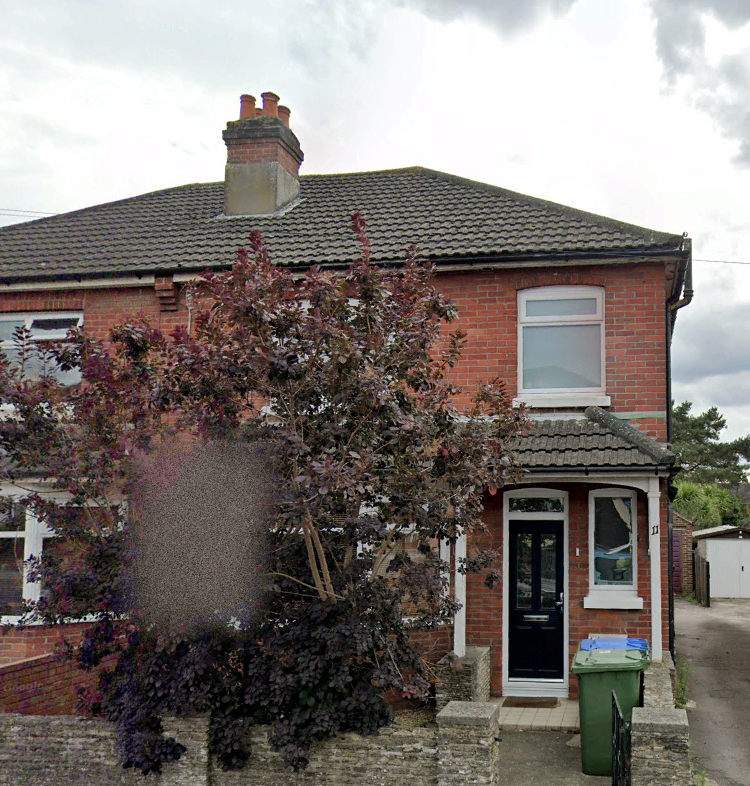
Figure 7. The Northover Residence at 11 Medina Road in
Shirley, Southampton.
(Image courtesy of Google Earth)
9. MARRIAGE, FAMILY AND PERSONAL INFORMATION
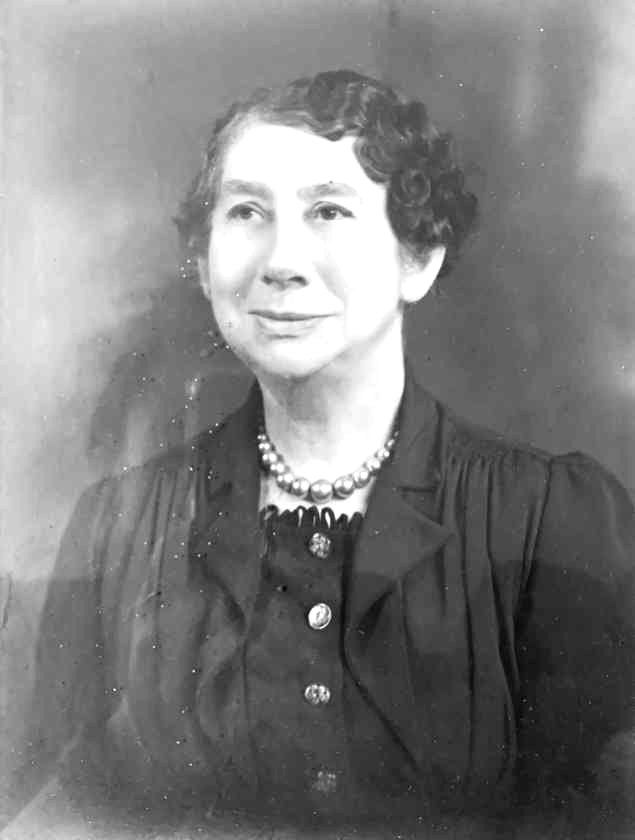
Figure 8. Gertrude Louise
Northover.
(Image courtesy
of David Brooks)
Spouse
Gertrude Louise Powell (1880-1966) was born on 29 October 1880 in Bitterne, Hampshire. She married George Thomas Northover at Southampton in 1909 while he was serving there at the Ordnance Survey headquarters. According to a family tree found on Ancestry.com, George and Gertrude had five children, three boys and two girls. Gertrude died in Winchester, Hampshire on 10 June 1966.
Children
Percy Northover (1901-1969) was born in Windsor, Berkshire on 27 October 1901. If Percy was the son of George Thomas Northover, then he was born while Lance Corporal Northover was serving in South Africa in the war against the Boers. The timing of his birth is questionable, as is the location. There is no indication that George was near Windsor while he was serving at Aldershot in preparation for his departure for South Africa. This information, taken from a Northover family tree, may be in error. It should also be noted that Percy does not appear in the 1911 Census of England, thus adding to the confusion regarding his being a member of the Northover family. Percy died in Breaston, Derbyshire on 9 September 1969.
Phyllis Ada Maude Northover (1911-1959) was born on 16 June 1911 in Southampton while Geoge was serving at the Ordnance Survey headquarters and she appears in the 1939 Register of England as the daughter of George and Gertrude, living on Rownhams Lane in Hampshire. Apparently she had never married. Phyllis died in Southampton on 22 August 1959.
Kenneth George Lambert Northover (1914-1996) was born in Hampshire on 31 December 1914 while is father was serving in France. Kenneth appears to have remained a bachelor all his life and he died in Hornsby, New South Wales, Australia on 10 August 1996.
Doris Gertrude Louise Northover (1916-2010) was born in Southampton on 31 January 1916 while her father was between postings at the Dardanelles and Dublin. No information was found regarding her being married. Doris died in Southampton on 6 September 2010.
William Northover (? – 1996). Little is known about William’s life except that he died in 1996.
REFERENCES:
Army Lists
Annual Army List, 1897, p. 442.
Monthly Army List, June 1926, pp. 338a and 975.
Monthly Army List, October 1935, pp. 333a and 974.
Books
1. GRIERSON, J.M. Scarlet Into Khaki: The British Army on the Eve of the Boer War. Greenhill Books, London, 1988, p. 185.
2. McINNES, I. Meritorious Service Medal. The Immediate Awards, 1916-1928. 2001. Naval & Military Press reprint (original publication 1992.).
SKELLEY, A.R. The Victorian Army at Home: The Recruitment and Terms and Conditions of the British Regular, 1859-1899. McGill-Queen’s University Press, Montreal, 1977, p. 262.
WATSON, C.M. History of the Corps of Royal Engineers, Volume III, Institution of Royal Engineers, reprinted, 1954.
History of the Corps of Royal Engineers, Volume V, Institution of Royal Engineers, reprinted, 1952.
Census
1891 Census of England (RG 12/1027).
1911 Census of England and Wales.
1939 Register of England (Romsey & Stockbridge, Hampshire).
Civil Documents
1956 Probate Calendar, p. 131.
Family Trees
George Thomas Northover (by The Chief 72).
Gertrude L. Northover - wife (by David Brooks).
Thomas Northover - father (by David Brooks).
Fanny Thurley – mother (by David Brooks).
Internet Web Sites
British Infantry Divisions of the Great War, 1914-1918 by Paul Reed
http://battlefields1418.50megs.com/divisions1.htm
Commonwealth War Graves Commission
https://www.cwgc.org/find-records/find-war-dead/
London Gazette
Third Supplement to the London Gazette, 22 June 1915, pp.5975 and 5988.
The London Gazette, 26 November 1929, p. 7660.
Medal Rolls
The Medal Roll of the Corps of Royal Engineers, Volume V. Queen’s South Africa and King’s South Africa Medals, 1899-1902. Institution of Royal Engineers, Chatham, Kent, undated.
Military Documents
Royal Engineers Medal Roll, 5th Company, Queen’s South Africa Medal.
Royal Engineers Medal Roll, 5th Company, King’s South Africa Medal.
Royal Engineers Roll, 5th Company, Clasps for the Queen’s South Africa Medal.
Medal Index Card of 33 Corporal George T. Northover, R.E.
Royal Engineers Medal Roll, British War Medal and Victory Medal.
Mention in Despatches Index Card, London Gazette, 22 June 1915.
War Diary, 57th Field Company, 1 – 17 March 1915.
Periodicals
The Sapper, March 1929.
The Sapper, May 1936, pp. 248 and 258.
Battle Honours of the Royal Engineers. The Royal Engineers Journal, 1925-1932. The Institution of Royal Engineers, Chatham, Kent
The Royal Engineers List, February 1905, Curragh Camp, p. xxv.
The Royal Engineers List, June 1905, Southampton, p. xxv.
The Royal Engineers List, January 1930, Quartermasters, p. xiii.
The Royal Engineers List, October 1935, Quartermasters, p. xiii.
The Royal Engineers List, 1943. Retired List, p. xxvii.
ENDNOTES:
[1] The black arm band being worn by Northover is to mourn the death of His Majesty King George V.
[2] Hounslow is a large suburban district of West London, about 11 miles west-southwest of Charing Cross.
[3] Hatfield is a town and civil parish in Hertfordshire, England, in the borough of Welwyn Hatfield. The settlement is of Saxon origin.
[4] The notation of his wound is found in The Sapper, May 1936, p. 248 in his Retirement notes.
[5] Later, Major General Sir George Scott-Moncrieff, KCB, KCMG, CIE.
[6] The Sapper, May 1936.
[7] Medal Index Card.
[8] Commonwealth War Graves Commission.
[9] The London Gazette, 22 June 1915.
[10] Now known as the Royal Engineers Association (R.E.A.)
[11] The location of Prices Café is now occupied by a Burger King restaurant.
[12] The London Gazette, 26 November 1929.
[13] The Royal Engineers List, 1943.
[14] McInnes.
[15] 1939 Register of England.